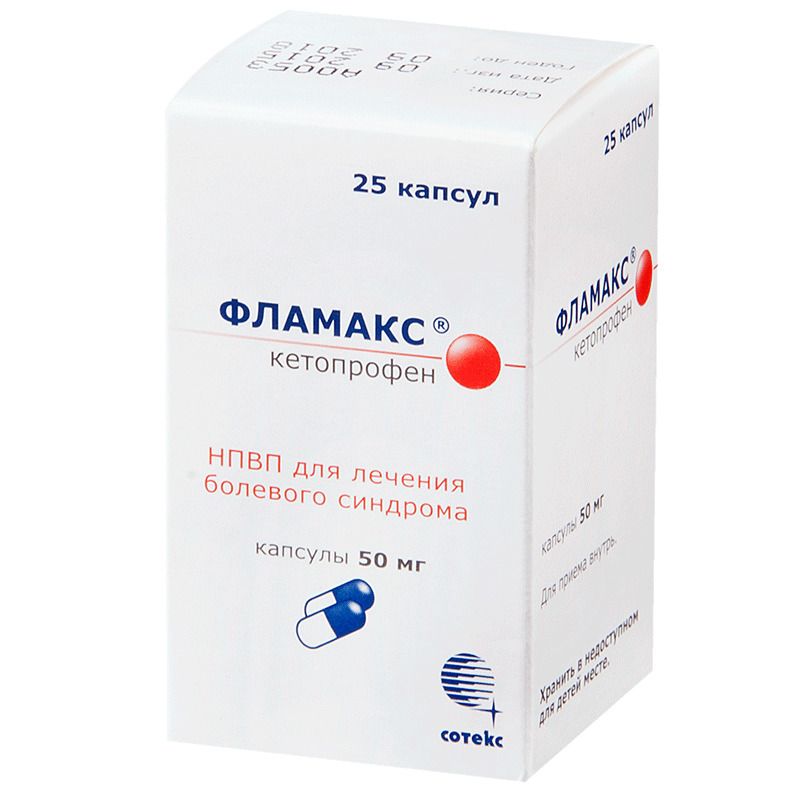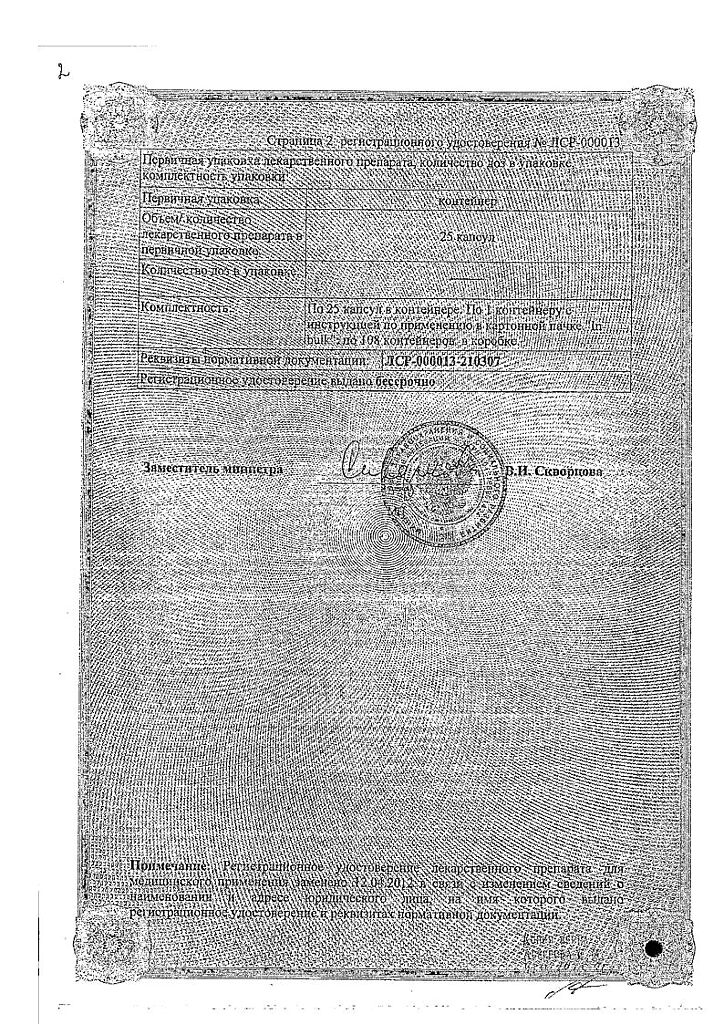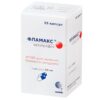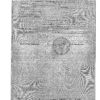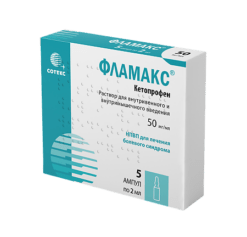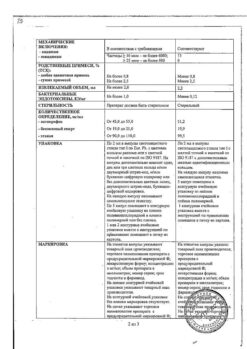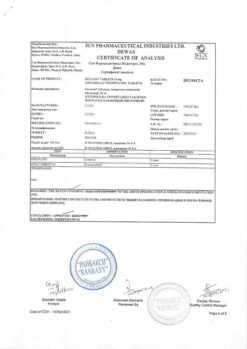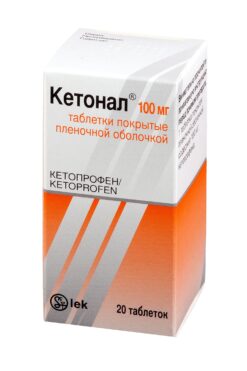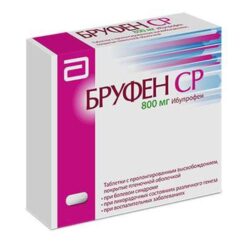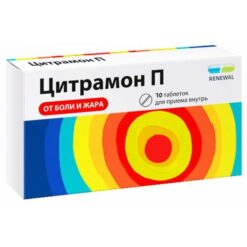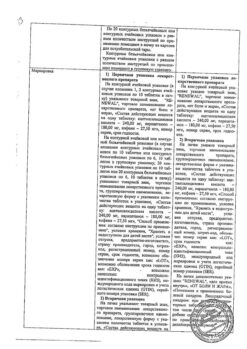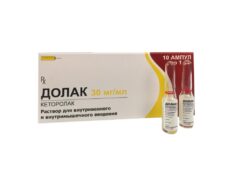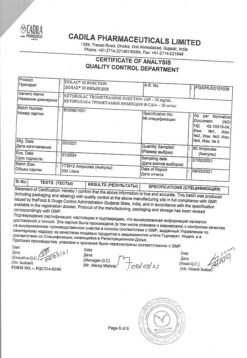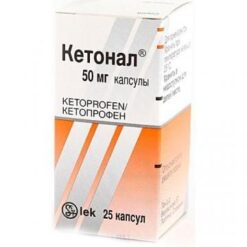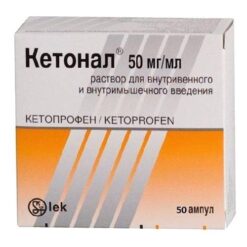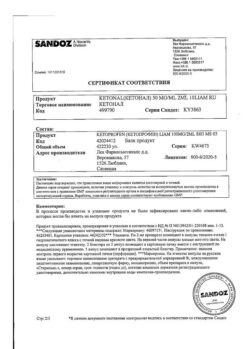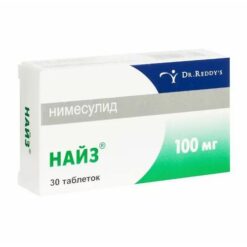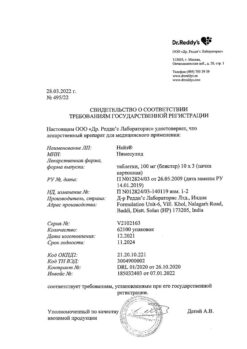No products in the cart.
Flamax, 50 mg capsules 25 pcs
€3.89 €3.46
Description
Pharmacodynamics
Non-steroidal anti-inflammatory drug (NSAID), propionic acid derivative. It has anti-inflammatory, analgesic and antipyretic, anti-aggregation effects.
Inhibits activity of cyclooxygenases 1 and 2 which regulate synthesis of prostaglandins. Analgesic effect is caused by both central and peripheral mechanisms. It has anti-bradykinin activity and stabilizes lysosomal membranes.
Pharmacokinetics
Absorption – fast, bioavailability – 90%. Up to 99 % of absorbed ketoprofen is bound with plasma proteins, mainly with albumin. Maximal concentration of the preparation in plasma (Cmax) is reached quickly (0.5-2 hours after oral administration) due to low volume of distribution (0.1-0.2 l/kg).
The equilibrium plasma concentration (Csс) of ketoprofen is reached 24 hours after the beginning of its regular administration. Ketoprofen penetrates well into the synovial fluid and connective tissues.
The maximum concentration in synovial fluid is 30% of the concentration in the serum, and 4-6 hours after intake exceeds it. Ketoprofen penetrates through the blood-brain barrier. It is almost completely metabolized in the liver by glucuronidation, has a “first pass” effect through the liver. It is excreted by kidneys (mainly) and intestines (1-8%).
The half-life of ketoprofen (T1/2) is 1.6-1.9 hours. In elderly patients the half-life increases to 3-5 hours, in patients with renal insufficiency (creatinine clearance 20-60 ml/min) it is about 3.5 hours. It does not cumulate.
Indications
Indications
Inflammatory and degenerative diseases of the musculoskeletal system: rheumatoid, psoriatic arthritis, ankylosing spondylitis (ankylosing spondylitis), gouty arthritis (in case of an acute attack of gout, fast-acting dosage forms are preferred), osteoarthritis.
Pain syndrome: myalgia, ossalgia, neuralgia, tendonitis, arthralgia, bursitis, radiculitis, adnexitis, otitis media, headache and toothache, in cancer, post-traumatic and postoperative pain syndrome accompanied by inflammation. Algodismenorrhea.
Pharmacological effect
Pharmacological effect
Pharmacodynamics
Non-steroidal anti-inflammatory drug (NSAID), a derivative of propionic acid. It has anti-inflammatory, analgesic and antipyretic, antiaggregation effects.
Suppresses the activity of cyclooxygenases 1 and 2, which regulate the synthesis of prostaglandins. The analgesic effect is due to both central and peripheral mechanisms. It has anti-bradykinin activity and stabilizes lysosomal membranes.
Pharmacokinetics
Absorption is fast, bioavailability is 90%. Up to 99% of absorbed ketoprofen is bound to plasma proteins, mainly albumin. The maximum concentration of the drug in plasma (Cmax) is achieved quickly (0.5-2 hours after oral administration) due to the low volume of distribution (0.1-0.2 l/kg).
The equilibrium concentration (Css) of ketoprofen in plasma is achieved 24 hours after the start of its regular administration. Ketoprofen penetrates well into synovial fluid and connective tissue.
The maximum concentration in synovial fluid is 30% of the serum concentration, and exceeds it 4-6 hours after administration. Ketoprofen penetrates the blood-brain barrier. It is almost completely metabolized in the liver by glucuronidation and has a “first pass” effect through the liver. Excreted by the kidneys (mainly) and intestines (1-8%).
The half-life of ketoprofen (T1/2) is 1.6-1.9 hours. In the elderly, the half-life increases to 3-5 hours, in patients with renal failure (creatinine clearance 20-60 ml/min) it is about 3.5 hours. It does not accumulate.
Special instructions
Special instructions
With the simultaneous use of ketoprofen and warfarin, as well as coumarin anticoagulants or lithium salts, patients should be under strict medical supervision.
Caution must be exercised when prescribing the drug to patients with a history of peptic ulcers of the gastrointestinal tract, renal or liver failure. During treatment, monitoring of the peripheral blood picture and the functional state of the liver and kidneys is necessary. If renal and liver function are impaired (increased ALT activity is the most sensitive indicator of NSAID-induced liver dysfunction), dose reduction and careful monitoring are necessary.
If it is necessary to determine 17-ketosteroids, the drug should be discontinued 48 hours before the study.
Like other drugs in this group, it can mask signs of an infectious disease.
If visual impairment develops, consultation with an ophthalmologist is necessary.
During the treatment period, care must be taken when driving vehicles and engaging in other potentially dangerous activities that require increased concentration and speed of psychomotor reactions.
Active ingredient
Active ingredient
Ketoprofen
Composition
Composition
active ingredient:
50 mg ketoprofen,
excipients:
lactose monohydrate,
microcrystalline cellulose,
croscarmellose sodium,
sodium lauryl sulfate,
povidone,
colloidal silicon dioxide.
Composition of gelatin capsule:
titanium dioxide, gelatin, indigo carmine FD&C blue.
Contraindications
Contraindications
– hypersensitivity to ketoprofen or to any component of the drug;
– a history of bronchial asthma caused by ketoprofen, another non-steroidal anti-inflammatory drug or acetisalicylic acid;
– recurrent peptic ulcer of the stomach and duodenum;
– peptic ulcer;
– severe liver failure;
– severe renal failure;
– insufficiency of the circulatory system;
– gastrointestinal, cerebrovascular and other bleeding (or suspected bleeding);
– pregnancy and lactation;
– children’s age (up to 15 years);
– hemophilia and other blood clotting disorders;
– ulcerative colitis, Crohn’s disease, diverticulitis.
With caution
Anemia, bronchial asthma, alcoholism, tobacco smoking, alcoholic cirrhosis of the liver, hyperbilirubinemia, hepatic and renal (since the drug is mainly excreted by the kidneys) failure, diabetes mellitus, dehydration, sepsis, chronic heart failure, edema, arterial hypertension, coronary heart disease, blood diseases (including leukopenia), stomatitis, childhood (over 15 years old), old age.
Pregnancy and lactation
The use of ketoprofen is contraindicated during pregnancy and lactation.
Side Effects
Side Effects
– From the digestive system: NSAID gastropathy, abdominal pain, dyspepsia (nausea, vomiting, heartburn, flatulence, loss of appetite, diarrhea), stomatitis; change in taste, ulceration and perforation of the mucous membrane of the gastrointestinal tract,
gingival, gastrointestinal, hemorrhoidal bleeding; increased activity of “liver” transaminases in the blood serum, hepatitis.
– From the nervous system: headache, dizziness, insomnia, agitation, nervousness, drowsiness, depression, asthenia, confusion or loss of consciousness, forgetfulness, migraine, peripheral neuropathy.
– From the senses: noise or ringing in the ears, blurred vision, conjunctivitis, dry mucous membrane of the eye, pain in the eyes, conjunctival hyperemia, hearing loss, vertigo.
– From the cardiovascular system: increased blood pressure, tachycardia.
– From the hematopoietic organs: rarely – agranulocytosis, anemia, hemolytic anemia, thrombocytopenia, leukopenia.
– From the urinary system: edema syndrome, cystitis, urethritis, renal dysfunction, interstitial nephritis, nephrotic syndrome, hematuria.
– From the respiratory system: hemoptysis, dyspnea, bronchospasm, rhinitis, laryngeal edema, nosebleeds, shortness of breath.
– From the skin: skin rash, alopecia and eczema, exudative erythema, incl. Stevens-Johnson syndrome, toxic epidermal necrolysis (Lyell’s syndrome), photodermatitis.
– Allergic reactions: skin rash (including erythematous, urticaria), skin itching, rhinitis, angioedema, exfoliative dermatitis, anaphylactic shock.
– Other: increased sweating, myalgia, muscle twitching, shortness of breath, thirst, vaginal bleeding.
Overdose
Symptoms: drowsiness, nausea, vomiting, abdominal pain, bleeding, liver and kidney dysfunction may occur.
Treatment is symptomatic: gastric lavage and/or activated carbon and/or other sorbents. There is no specific antidote.
Interaction
Interaction
Reduces the effectiveness of uricosuric drugs, enhances the effect of anticoagulants, antiplatelet agents, fibrinolytics, ethanol, side effects of glucocorticosteroids and mineralocorticosteroids, estrogens; reduces the effectiveness of antihypertensive drugs and diuretics.
Combined use with other NSAIDs, glucocorticosteroids, ethanol, corticotropin can lead to the formation of ulcers and the development of gastrointestinal bleeding, increasing the risk of developing renal dysfunction.
Simultaneous administration of oral anticoagulants, heparin, thrombolytics, antiplatelet agents, cefoperazone, cefamandole and cefotetan increases the risk of bleeding.
Increases the hypoglycemic effect of insulin and oral hypoglycemic drugs (dose recalculation is necessary).
Inducers of microsomal oxidation in the liver (phenytoin, ethanol, barbiturates, rifampicin, phenylbutazone, tricyclic antidepressants) increase the production of hydroxylated active metabolites.
Co-administration with sodium valproate causes disruption of platelet aggregation.
Increases plasma concentrations of verapamil and nifedipine, lithium preparations, methotrexate.
Antacids and cholestyramine reduce absorption.
Myelotoxic drugs increase the manifestations of hematotoxicity of the drug.
Storage conditions
Storage conditions
Store in a dry place, protected from light, at a temperature not exceeding 25 °C. Keep out of the reach of children.
Shelf life
Shelf life
3 years.
Manufacturer
Manufacturer
Replek Farm, Republic of North Macedonia
Additional information
| Shelf life | 3 years. |
|---|---|
| Conditions of storage | Store in a dry, light-protected place at a temperature not exceeding 25 oC. Keep out of reach of children. |
| Manufacturer | PharmFirm Sotex, Russia |
| Medication form | capsules |
| Brand | PharmFirm Sotex |
Other forms…
Related products
Buy Flamax, 50 mg capsules 25 pcs with delivery to USA, UK, Europe and over 120 other countries.

